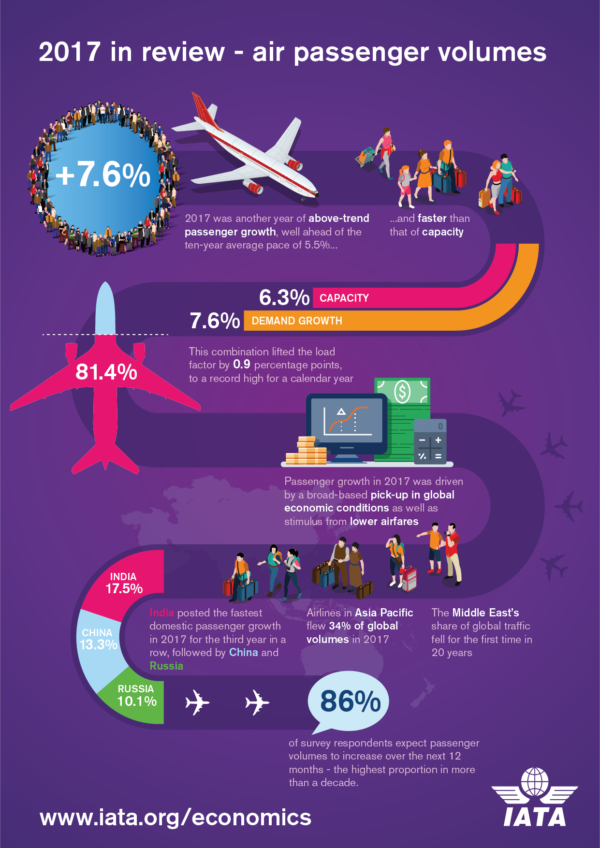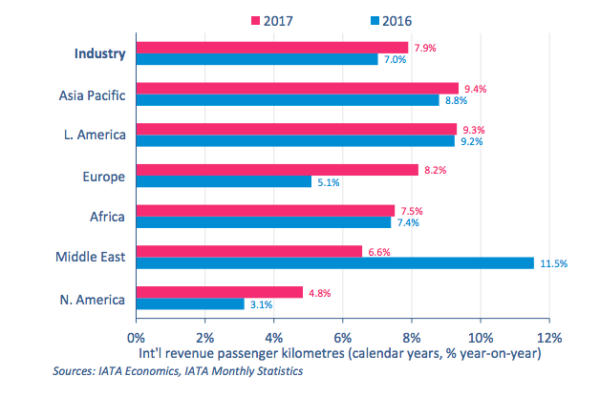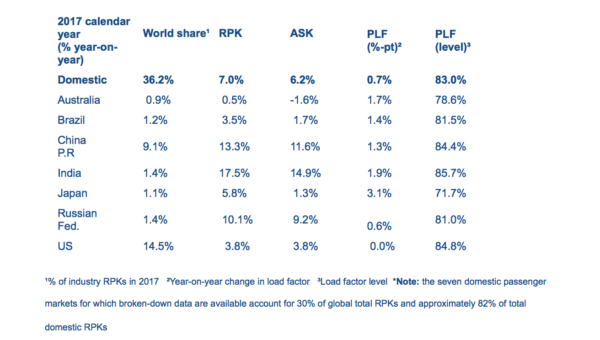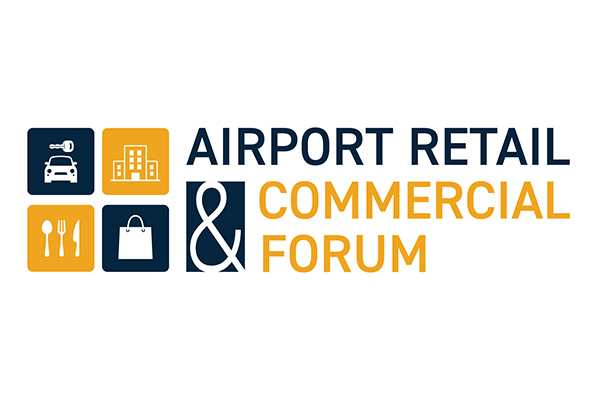INTERNATIONAL. Global airline passenger traffic (measured in revenue passenger kilometres) increased by a sharp +7.6% year-on-year in 2017, according to the International Air Transport Association (IATA). Air passenger volumes amounted to over 4 billion in the year, noted the association.
The healthy growth rate was well above the average annual traffic increase of +5.5% over the past ten years. Worldwide airline capacity rose +6.3% in 2017 and load factor was at a record high of 81.4%.  “2017 got off to a very strong start and largely stayed that way throughout the year, sustained by a broad-based pick-up in economic conditions,” said IATA Director General and CEO Alexandre de Juniac.
“2017 got off to a very strong start and largely stayed that way throughout the year, sustained by a broad-based pick-up in economic conditions,” said IATA Director General and CEO Alexandre de Juniac.
“While the underlying economic outlook remains supportive in 2018, rising cost inputs, most notably fuel, suggest we are unlikely to see the same degree of demand stimulation from lower fares that occurred in the first part of 2017.”
International traffic
International passenger traffic soared +7.9% compared to 2016, with growth driven by better global economic conditions and lower airfares, according to IATA.
All regions recorded year-on-year increases in demand, led by Asia Pacific and Latin America.
Asia Pacific posted growth of +9.4 year-on-year in international traffic, driven by robust regional economic expansion and an increase in the number of routes. This was the first time since 1994 that Asia Pacific led all the regions in its annual growth rate. Capacity rose +7.9%, and load factor climbed 1.1% to 79.6%.

airline region of registration. Source: IATA
European international traffic climbed +8.2% compared to 2016, underpinned by buoyant economic conditions. Capacity rose +6.1% and load factor surged +1.6% to 84.4%, the highest for any region.
Middle Eastern international traffic increased +6.6% last year. The region was the only one to see a slowdown in annual growth compared to 2016 (+11.5%), and the region’s share of global traffic (9.5%) fell for the first time in 20 years.
North American airlines saw the fastest demand growth since 2011, with traffic rising +4.8% year-on-year in 2017. Capacity climbed +4.5%, and load factor grew 0.3% to 81.7%.
A comparatively robust economy supported outbound passenger demand in North America. This was offset by a slowdown in inbound travel resulting from new immigration and security restrictions in the US, and extreme weather events.
Latin American traffic climbed +9.3% in 2017, the fastest rate since 2011. However, the upward trend weakened towards the end of the year due to the impact of extreme weather. Capacity rose +8% and load factor increased +1% to 82.1%, second highest among the regions.
African airlines saw 2017 traffic rise +7.5% compared to 2016. Capacity rose at less than half the rate of demand (+3.6%), and load factor jumped to 70.3%. South Africa’s falling economic output was a challenge while Nigeria returned to growth backed by a recent rise in oil prices, said IATA.
Domestic traffic

Domestic air travel worldwide climbed by +7% last year. All markets showed annual growth led by India, China and Russia. Capacity increased +6.2% and load factor was 83%, up +0.7%.
Japan posted its strongest year of growth (+5.8%) since 2013, driven by the country’s stronger economic backdrop.
Brazil’s domestic traffic returned to growth last year with a +3.5% demand increase, after declining -5.5% in 2016.
“Last year, more than 4 billion passengers used aviation to reunite with friends and loved ones, to explore new worlds, to do business, and to take advantage of opportunities to improve themselves.
“The connectivity provided by aviation enables goods to get to markets, and aid to be delivered to those in need. Aviation truly is the business of freedom, liberating us from the restraints of geography to lead better lives. Aviation can do even more in 2018, supported by governments that recognise and support our activities with smarter regulation, fairer taxation, cost efficient infrastructure and borders that are open to people and trade,” said de Juniac.












